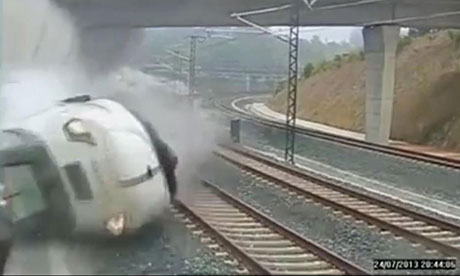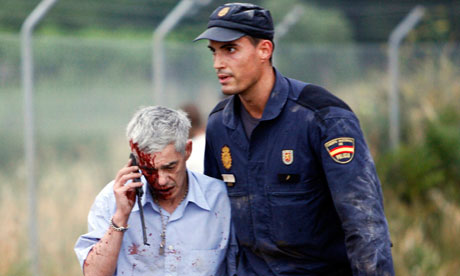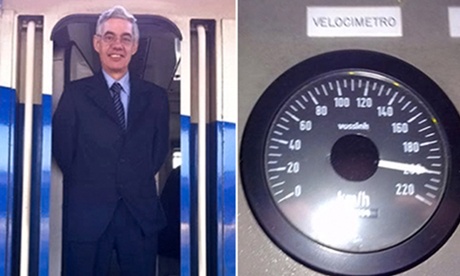World Class


The train just after it derailed near Santiago de Compostela in Spain. Photograph: AP
The black boxes from the high-speed train that hurtled off the tracks in north-west Spain have been recovered from the wreckage and handed to investigators, officials say.
The recorders, which register speed, distances and other data, are crucial to resolving the mystery of why the Alvia 151 shot into a tight bend in the approach to Santiago de Compostela at more than twice the approved speed.
El País reported that the driver, 52-year-old Francisco José Garzón, had received an order to reduce speed just seconds before the crash, and acknowledged it by pressing a button in the drivers' cab. It remained unclear whether he had been unable or unwilling to brake the train, which was running five minutes behind schedule.
A spokeswoman for the courts in Santiago del Compostela, María Pardo Ríos, confirmed on Friday that the train's "black boxes" had been found, but did not indicate how long the analysis would take.
 A newly issued photograph of an injured man, identified by El País
and El Mundo as the train driver, Francisco José Garzón. Photograph:
Reuters
Police revised the death toll on Thursday to 78, but said the count
could change as body parts were identified. Antonio del Amo, head of the
Spanish national police's central forensic unit, said 78 bodies had
been recovered, together with numerous body parts. He said that six of
the corpses had yet to be identified.
A newly issued photograph of an injured man, identified by El País
and El Mundo as the train driver, Francisco José Garzón. Photograph:
Reuters
Police revised the death toll on Thursday to 78, but said the count
could change as body parts were identified. Antonio del Amo, head of the
Spanish national police's central forensic unit, said 78 bodies had
been recovered, together with numerous body parts. He said that six of
the corpses had yet to be identified.
The city's police chief, Jaime Iglesias, said the driver of the train had been under arrest since Thursday evening. But Pardo Ríos said he would not be interrogated on Friday.
Garzón was led from the scene of the tragedy with his face covered in blood. He was given nine stitches to a head wound, but was otherwise apparently unharmed.
The driver spent the night in hospital with his mother at his bedside and under police guard. Contacted by telephone by the regional newspaper, La Voz de Galicia, Garzón refused to comment beyond saying "You [can] imagine how I am."
In a recorded call to the emergency services shortly after the disaster, Garzón reportedly said: "I should have been going at 80 [km/h] and I am [sic] going at 190." He reportedly added: "Let's hope there aren't any dead."
 The train driver Francisco José Garzón and a speedometer reading he
previously posted on Facebook boasting about the speeds he reached.
Enterprise News and Pictures
Garzón reportedly tested negative for alcohol following the crash.
The train driver Francisco José Garzón and a speedometer reading he
previously posted on Facebook boasting about the speeds he reached.
Enterprise News and Pictures
Garzón reportedly tested negative for alcohol following the crash.
Colleagues described Garzón as an experienced railwayman who had worked for Spain's national rail company, Renfe, for around 30 years. He had been a driver since 2003. The company's president, Julio Gómez-Pomar Rodríguez, said Garzón, from Monforte de Lemos, also in Spain's north-west, had worked on the Ourense to Santiago stretch of the high-speed network where the accident took place for more than a year.
Garzón's position was compromised by the emergence of a photograph that he posted to his Facebook page showing his speedometer at 200km/h. It was not clear if, when the photograph was taken, he was on a stretch of the network where high speeds were permitted.
It nevertheless surprised Garzón's friends. One wrote: "You're going like the bloody clappers, lad. Brake." The driver replied: "I'm at the limit. I can't go faster, otherwise they'll fine me."
The daily El Mundo, which first published the photograph and the exchange of messages on its website, said that they had been removed from Garzón's Facebook page.
The accident took place just after the point at which one safety system gives way to another. For the first 80km after Ourense, the line is ostensibly governed by the EU-sponsored European Rail Traffic Management System (ERTMS), which would have braked the train automatically. However, on the approach to Santiago de Compostela station the track is subject to Spain's ASFA system. This will stop a train altogether, but only if it is travelling at more than 200km an hour.
At lower speeds, warning signals are emitted. But it is left to the driver to implement them.
The train derailed just a few hundred metres beyond the cut-off point for the ERTMS, raising the question of why the system did not intervene to brake the train earlier.
El País quoted a government source as saying that, even on the stretch of the line on which the ERTMS had been installed since November 2011, it was not used. No reason was given.
According to Renfe, there were 218 passengers and five railway staff on the train involved. It is Spain's worst rail accident for more than 40 years. By late on Friday morning, 83 people were still in hospital, with 32 of them on the critical list.
Source: Theguardian
The recorders, which register speed, distances and other data, are crucial to resolving the mystery of why the Alvia 151 shot into a tight bend in the approach to Santiago de Compostela at more than twice the approved speed.
El País reported that the driver, 52-year-old Francisco José Garzón, had received an order to reduce speed just seconds before the crash, and acknowledged it by pressing a button in the drivers' cab. It remained unclear whether he had been unable or unwilling to brake the train, which was running five minutes behind schedule.
A spokeswoman for the courts in Santiago del Compostela, María Pardo Ríos, confirmed on Friday that the train's "black boxes" had been found, but did not indicate how long the analysis would take.
 A newly issued photograph of an injured man, identified by El País
and El Mundo as the train driver, Francisco José Garzón. Photograph:
Reuters
Police revised the death toll on Thursday to 78, but said the count
could change as body parts were identified. Antonio del Amo, head of the
Spanish national police's central forensic unit, said 78 bodies had
been recovered, together with numerous body parts. He said that six of
the corpses had yet to be identified.
A newly issued photograph of an injured man, identified by El País
and El Mundo as the train driver, Francisco José Garzón. Photograph:
Reuters
Police revised the death toll on Thursday to 78, but said the count
could change as body parts were identified. Antonio del Amo, head of the
Spanish national police's central forensic unit, said 78 bodies had
been recovered, together with numerous body parts. He said that six of
the corpses had yet to be identified.The city's police chief, Jaime Iglesias, said the driver of the train had been under arrest since Thursday evening. But Pardo Ríos said he would not be interrogated on Friday.
Garzón was led from the scene of the tragedy with his face covered in blood. He was given nine stitches to a head wound, but was otherwise apparently unharmed.
The driver spent the night in hospital with his mother at his bedside and under police guard. Contacted by telephone by the regional newspaper, La Voz de Galicia, Garzón refused to comment beyond saying "You [can] imagine how I am."
In a recorded call to the emergency services shortly after the disaster, Garzón reportedly said: "I should have been going at 80 [km/h] and I am [sic] going at 190." He reportedly added: "Let's hope there aren't any dead."
 The train driver Francisco José Garzón and a speedometer reading he
previously posted on Facebook boasting about the speeds he reached.
Enterprise News and Pictures
Garzón reportedly tested negative for alcohol following the crash.
The train driver Francisco José Garzón and a speedometer reading he
previously posted on Facebook boasting about the speeds he reached.
Enterprise News and Pictures
Garzón reportedly tested negative for alcohol following the crash.Colleagues described Garzón as an experienced railwayman who had worked for Spain's national rail company, Renfe, for around 30 years. He had been a driver since 2003. The company's president, Julio Gómez-Pomar Rodríguez, said Garzón, from Monforte de Lemos, also in Spain's north-west, had worked on the Ourense to Santiago stretch of the high-speed network where the accident took place for more than a year.
Garzón's position was compromised by the emergence of a photograph that he posted to his Facebook page showing his speedometer at 200km/h. It was not clear if, when the photograph was taken, he was on a stretch of the network where high speeds were permitted.
It nevertheless surprised Garzón's friends. One wrote: "You're going like the bloody clappers, lad. Brake." The driver replied: "I'm at the limit. I can't go faster, otherwise they'll fine me."
The daily El Mundo, which first published the photograph and the exchange of messages on its website, said that they had been removed from Garzón's Facebook page.
The accident took place just after the point at which one safety system gives way to another. For the first 80km after Ourense, the line is ostensibly governed by the EU-sponsored European Rail Traffic Management System (ERTMS), which would have braked the train automatically. However, on the approach to Santiago de Compostela station the track is subject to Spain's ASFA system. This will stop a train altogether, but only if it is travelling at more than 200km an hour.
At lower speeds, warning signals are emitted. But it is left to the driver to implement them.
The train derailed just a few hundred metres beyond the cut-off point for the ERTMS, raising the question of why the system did not intervene to brake the train earlier.
El País quoted a government source as saying that, even on the stretch of the line on which the ERTMS had been installed since November 2011, it was not used. No reason was given.
According to Renfe, there were 218 passengers and five railway staff on the train involved. It is Spain's worst rail accident for more than 40 years. By late on Friday morning, 83 people were still in hospital, with 32 of them on the critical list.
Source: Theguardian
No comments:
Post a Comment
Thanks for your comment, keep reading our news and articles